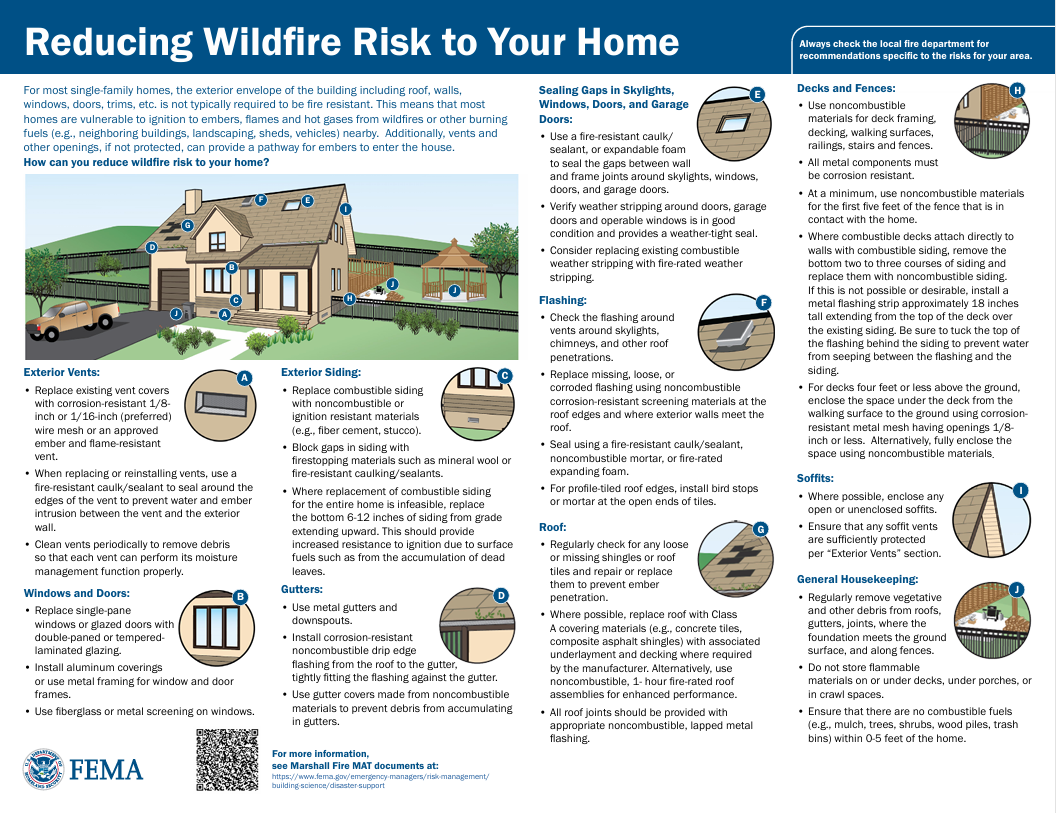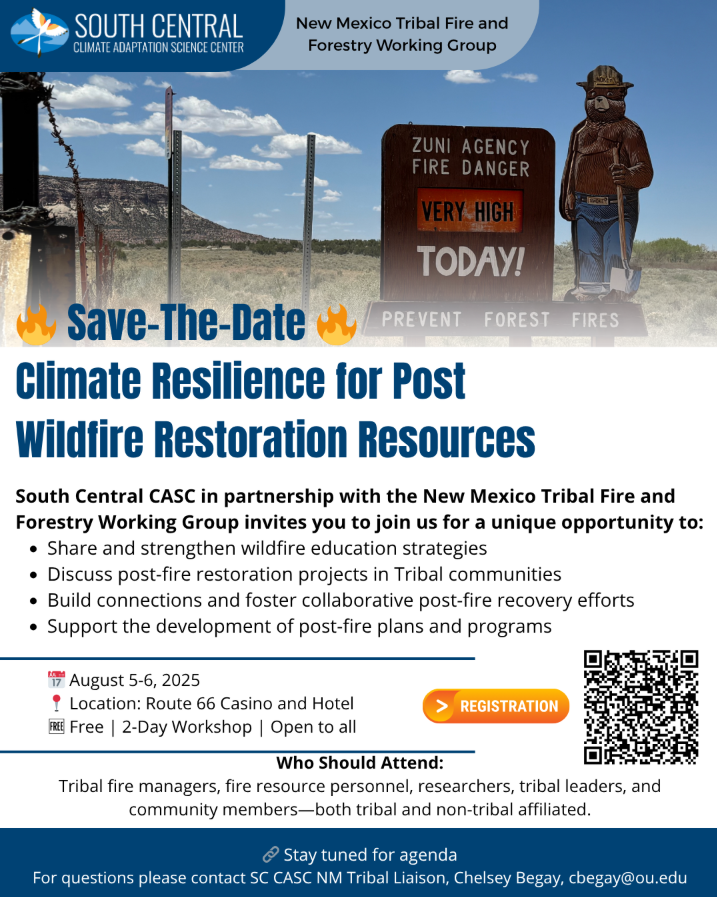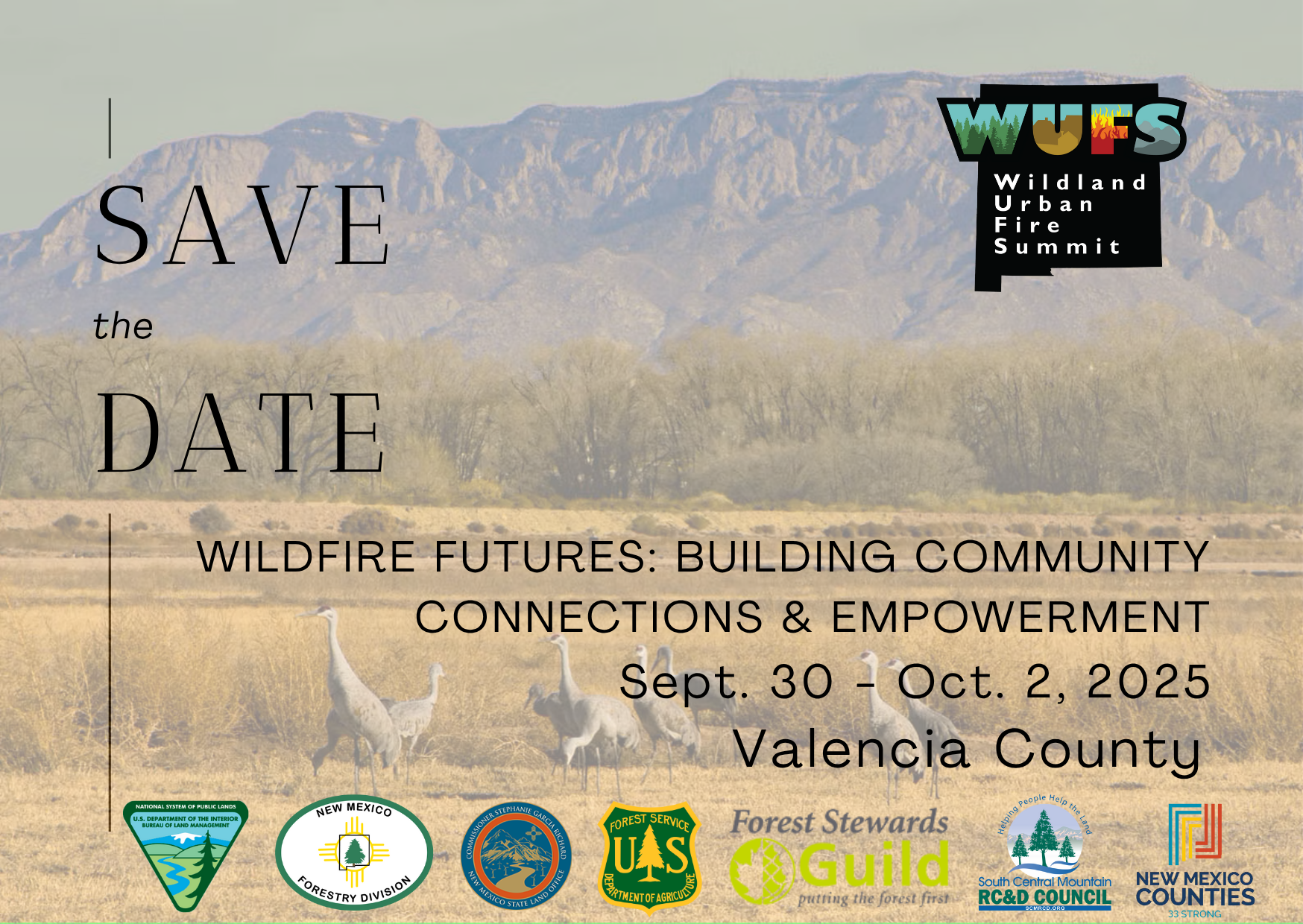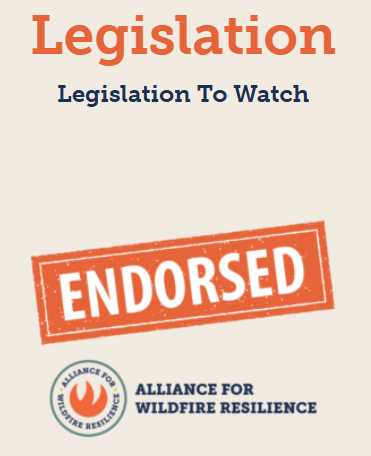Happy Wednesday, and happy Summer Solstice, FAC readers!
How do some homes and structures survive even when they are in the direct path of a wildfire? Most of us know that defensible space - an area around the home where vegetation, including trees, shrubs, and grass, is thinned or removed to reduce fire behavior and intensity as it approaches the house - can make a difference. However, many of the homes that survive fire events share another feature: fire resistant construction and design. Today we will be talking about building materials, architecture, how we can improve the fire resilience of our existing housing stock, and how to build better with fire in mind during new construction.
This Wildfire Wednesday features:
Education opportunity for learning how to create fire safe homes
New! New Mexico grants database from FACNM
Upcoming events
Wildfire legislation tracker
In the news - upcoming radio show
Getting Started: Basic Recommendations for Non- and Less-Combustible Building Materials
“Homeowners, business owners, design professionals and builders in wildfire-prone regions can benefit from understanding general fire resistance characteristics of common construction materials and building products. Fire-resistant materials can withstand higher exposure and help slow the spread of fire, but it is important to remember that fire-resistant does not mean fire-proof. Fire resistance depends on a variety of factors including intensity and duration of fire exposure, type of building material, age of the material, detailing at joints and interfaces, methods of construction, and how each element and assembly are used in combination to create a fire-resistant exterior.” (FEMA Maui Recovery Advisory, 2025)
FEMA has released several Mitigation Assessment reports following investigation of destructive wildfires and urban conflagrations with recommendations for what actions home and business owners can take to improve their structure’s chances of surviving a fire. The following recommendations are from reports out of Maui, Hawai’i and Boulder County, Colorado.
Structural components






When components and assemblies of homes such as walls, roofs, windows, doors, and siding systems are connected they leave exposed surfaces, form joints or spaces at the connection points. These joints and spaces help accommodate building movements and construction tolerances. They also are places where vegetative debris (e.g., leaves, needles, grass clippings, twigs, branches, etc.) tends to accumulate. While current building codes do require fire-resistant construction, homes constructed following older codes may have exterior walls that are susceptible to fire depending on the construction and/or materials used to construct them. Single-family homes typically do not have exterior walls that are built to resist wildfire, which means they have the potential to allow surfaces to be exposed to embers, flames, and hot gases or enter the home through the exterior envelope.
The biggest areas for improvement in the structural components of a house include roofing material, structural wall materials (e.g. using adobe brick, concrete, or masonry as an alternative to timber framing in new construction, or adding fire resistant siding/cladding to existing housing),
Windows and doors



Wind-blown embers can accumulate in gaps in a home’s siding, pass through openings around windows and doors, or accumulate on wooden window and door frames. Glass in a window or door can break from radiant heat or flame contact, exposing the interior of the home.
Wildfire resistant siding and installation design features, tempered and dual pane glass in windows, wildfire resistant doors, metal clad frames, and weather-stripping can reduce home vulnerability. The relative importance of each of these items varies depending on home-to-home spacing and location of vegetation on the property.
Exterior components





Vents in roofs, walls, and crawl spaces provide the air circulation needed to minimize moisture buildup that can lead to significant damages over time. These vents, if not sealed, provide a pathway for embers to enter the house, resulting in possible ignition inside the structure.
Current research indicates that decks, porches, balconies, and exterior stairs are often constructed of non-fire-resistant materials which embers can ignite. Vegetative debris can accumulate on or under these structures. These structures can ignite when directly exposed to embers or direct flaming. Because they are often adjacent or attached to the vulnerable components (e.g., glass doors and windows) of the house, once they ignite, fire can spread to the house itself.
Fences constructed from combustible materials and having joints or spaces between components (such as post-and-board fences) can allow embers to collect in the joints and gaps. Flames can travel horizontally along combustible fences when ignited, acting as a “wick.” When the fence is attached to the home, these flames can then ignite the house itself. Fences within the first five feet of the house pose the greatest risk of flames igniting combustible siding or embers and flames igniting the under-eave area and the roof edge.
Less combustible vegetation in the 5-foot zone
We know that wildland vegetation such as grass, brush, and timber can be extremely combustible, burning with great intensity and producing firebrands and burning embers that can become wind-driven hazards. Did you know that landscape vegetation can be as combustible as wildland vegetation? Combustible plants have these characteristics:
Volatile resins and oils (generally aromatic when crushed)
Narrow leaves or long, thin needles such as conifer needles
Waxy or fuzzy leaves
An accumulation of dead leaves and twigs on and under the plant
Loose or papery bark
A wildfire can move horizontally from shrub to shrub and tree to tree or can travel vertically from the ground up into the treetops, resulting in a catastrophic crown fire (a fire that can travel at an incredible pace through the top of a forest).
Desirable substitutions for flammable vegetation close to the home include irrigated grass, rock gardens, stone patios, or less flammable vegetation. Keep in mind that flammability fluctuates with the season - there are no “fireproof” plants, there are only less flammable plants. The following resources have some recommendations for fire resistant landscaping:
FireWise Plant List published by New Mexico Forestry Division: WUI plant list
Low-Flammability Landscape Plants (Colorado State University): Low Flammability Plants Fact Sheet
Fire-Resistant Landscaping (Colorado State University): Fire-Resistant Landscaping Fact Sheet
The webinar recording from FACNM, below, discusses options for fire smart landscaping in New Mexico. Jump to timestamp 29:15 to learn more about consideration of fire in plant and landscape design.
Fire Resistant Homes: Education Opportunity
The National Fire Protection Agency (NFPA) offers a free self-paced course to anyone interested in understanding how wildfires spread to buildings and the steps they can take to prevent ignition and destruction. Participants can select each element of a building—roof, windows, siding, vents—to get a complete view of how fire can affect it, and what changes can be made to make the whole structure much safer. As each section is completed, the program will add it to a personalized property improvement plan, which can be downloaded later or printed for personal use.
The course also comes with a free mobile app, NFPA Wildfire Risk Simulator. This is a great starting place for individuals who may not have access to a fire management professional offering a personalized home hazard assessment, or for those who simply want to learn more.
The Cost of Ignition and Fire Resistance
Decades of construction on wildfire-prone lands that have largely disregarded wildfire-resistant building techniques have left communities vulnerable. It is essential to build better and to retrofit the existing housing stock in wildfire-prone areas to an upgraded wildfire resistant construction standard to reduce overall community wildfire risk. But how much does it cost to build or retrofit a home to be fire resistant?
Headwater Economics has been studying this question for the past decade and has released two excellent reports that detail the costs and benefits of building for fire resistance. While retrofits may be more expensive than building with fire safe materials from the ground-up, the benefits of improving a home’s fire resistance rating are only growing as more homeowners across the West experience the loss of, or increase in rates for, homeowner’s and business insurance due to fire risk.
The reports from IBHS examine costs in four vulnerable components of the home: the roof (including gutters, vents, and eaves), exterior walls (including windows and doors), decks, and near-home landscaping. Overall, the wildfire-resistant construction costs 2% less than the typical construction, with the greatest cost savings resulting from using wildfire-resistant fiber cement siding on exterior walls, in lieu of typical cedar plank siding.
In addition to considering the cost of this type of construction, the reports (‘Retrofitting’ in particular) also offer detailed construction options, cost breakdowns, diagrams, and decision trees for specific home zones and fire vulnerable areas.
This study examines the cost differences between a typical home and a home constructed using wildfire resistant materials and design features.
This report identifies the costs for retrofitting existing structures to meet CA construction requirements and the best available science for ignition-resistant construction.
Analysis demonstrates that some of the most effective strategies to reduce structure vulnerability to wildfire can be done affordably. For homeowners concerned about the cost of retrofitting their homes, selective, targeted replacement of particular components may reduce risk effectively and more affordably. Homes must be built to be stronger, smarter, and more durable in light of the increasing pace and scale of wildfire risks, and these individual actions must be paired with funding and technical support from state and federal governments in order to be successful.
Additional Resources
New! Grant Opportunity and Funding Database
This new resource from FACNM is intended to assist folks across the state who are searching for grant funding opportunities. It can guide your funding search and is built using the best publicly available information. Please verify all details, including deadlines, eligibility requirements, and application procedures directly with the funding agency before applying.
The Forest Stewards Guild would like to acknowledge the generous support of the Watershed Research and Training Center and the Bureau of Land Management – New Mexico, whose contributions helped make this tool a reality.
………………………………………………….
Upcoming events
Climate Resilience for Post-Wildfire Restoration Resources
August 5-6, 2025, Route 66 Casino & Hotel (Albuquerque, NM)
The South-Central Climate Adaptation Science Center (SC CASC) is hosting a workshop on wildfire education strategies, collaborative post-fire restoration and recovery, and post-fire plans and programs. Open to all, this event will center Indigenous perspectives, local knowledge, and scientific collaboration to promote safer, more resilient communities in the face of increasing wildfire risk. To register, visit: https://docs.google.com/forms/d/e/1FAIpQLScw_lW2junpyIfH4J7Gm-V5gkRamwzfpHGer8KfvO9iIEMViw/viewform
New Mexico Wildland Urban Fire Summit (WUFS)
September 30-October 2, 2025, Valencia Co. NM
This annual event, open to the public, features presentations, panels, and interactive sessions on the topic of fire in our communities and the wildland urban interface. This year’s theme is Wildfire Futures: Building Community Connections and Empowerment and will feature discussions on defensible space and home hardening standards, insurance, community wildfire risk ratings, and much more. Save the date and keep an eye out for registration and additional information, coming soon!
………………………………………………….
Wildfire legislation tracker
The Alliance for Wildfire Resilience (AWR) released a brand new Bill and Recommendations Explorer that can be used to track wildfire-related legislation, the status of recommendations of the Wildland Fire Mitigation and Management Commission, and how Congress is progressing toward solutions. You can search for information by recommendation or bill, and further sort by topic, status, relevant department, and other features. Embedded within the bill tracker, you’ll find a map of wildfire risk for relevant congressional districts. This information will help users track, explore, and evaluate wildfire-related bills in Congress.
………………………………………………….
In the News
On June 26 from 1pm to 2pm, KRWG public media station will be hosting several wildfire experts (including our own Megan Rangel-Lynch) to discuss fire adapted communities, insurance in New Mexico, actions on recent wildfire-related legislation, and more. The program may be livestreamed on Facebook Live or accessed on the following radio stations:
